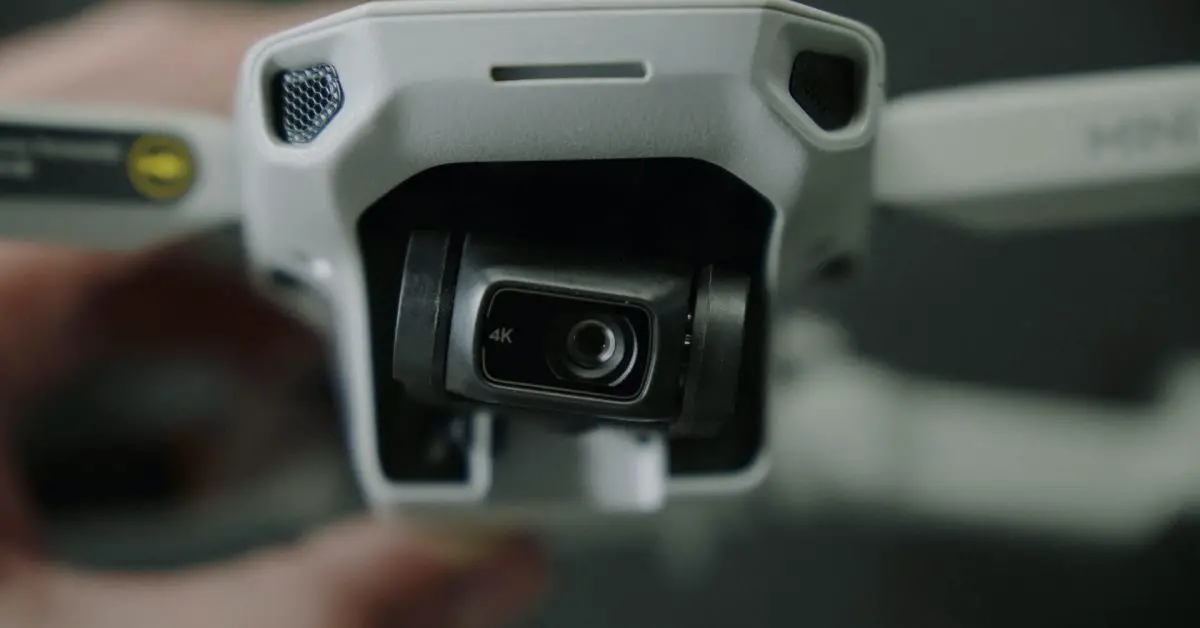If you’re someone who plans on buying a drone because it has a gimbal, someone that has already bought a drone and wants to add a gimbal to it themselves, or someone who’s just curious about what a drone gimbal is, then this post is meant for you.
Gimbal technology has been around for several years. However, it has only recently been widely available and relatively affordable on the market. Gimbals have been used to keep equipment and instruments upright on boats and to keep cameras in a fixed position no matter the movement of the object they are attached to.
These are devices that have been used for professional photography/videography and filmmaking for a long time.
They are considered a must have in the filmmaking industry, and in the past were only found at unbelievable prices, and people were willing to pay these prices which shows how beneficial they are to have.
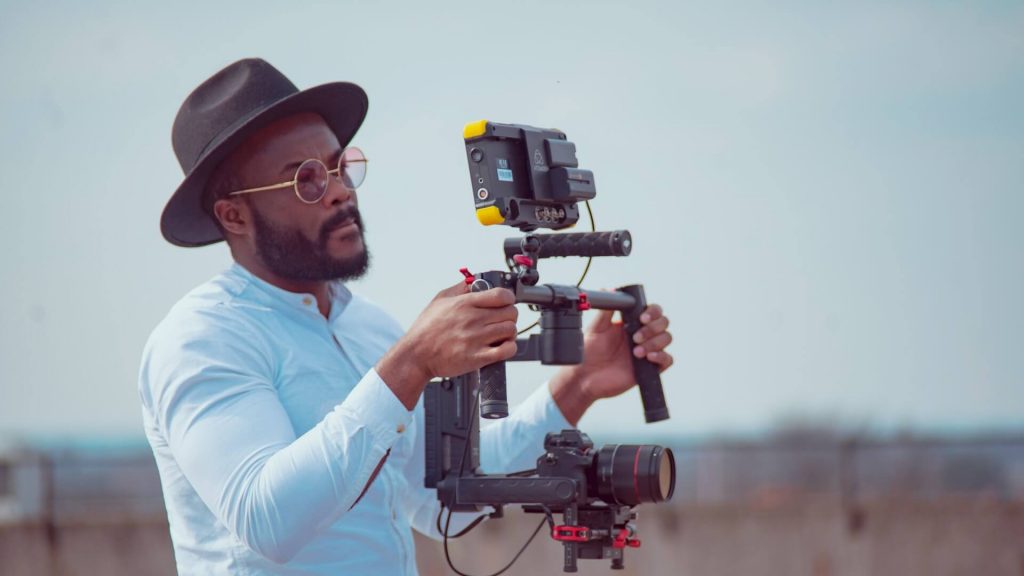
This technology has now become an expectation for drones that are more on the expensive side. This is due to the fact that the leading use of drones today is for photography and videography.
Having stable, professional-grade footage has become an expectation for most consumer and commercial drone pilots.
Now before we proceed, let’s get the definitions out of the way.
What is a drone gimbal?
A drone gimbal is a support system that provides stability to an object no matter the movement of what it’s attached to. Drone gimbals can come as 1-axis, 2-axis or 3-axis gimbals. The more the axes, the more stable the footage will be as there are more brushless motors at work. However, more axes also means more weight resulting in shorter flight times.
Now that we know what a drone gimbal is, it’s also important to know whether a drone really needs a gimbal.
Do Drones Need Gimbals?
Drones do not need gimbals. Gimbals are a luxurious technology that should only be used by those that have the money to spend and those that will be using their drones for photography, videography, filmmaking or any other application that requires high-quality footage.
Gimbals make it a lot easier for those that want the best footage possible while traveling a few hundred feet in the air.
Their sophisticated technology allows for a nearly fully automated process which allows you, the user, to focus almost completely on flying your drone to the desired position and in the direction of the area you want to capture.
If you don’t plan on using your drone to capture any footage, then you won’t need to buy a drone gimbal. You won’t even need to invest in a drone that has a camera, although it may be hard to find one without a camera if you’re paying a fair amount of money for the drone.
If you’re interested in finding out some of the differences between cheap drones and expensive ones, we have a full post that dives into detail on this topic:
Related Post: Cheap VS Expensive Drones – Everything A Beginner Drone Pilot Should Know
It’s up to you to decide whether or not you need one as it all depends on your needs and your intentions.
Now if you’re still interested in getting one, or getting a drone that specifically has one, then you should know the different types of drone gimbals available to you.
What Types Of Drone Gimbals Are There?
Most drones available on the market today that have cameras are going to have a gimbal built-in, especially the pricier ones. However, what you’ll see is that these gimbals have a different amount of axes.
Gimbals come as either 1-axis, 2-axis or 3-axis systems which control respectively the tilt, pan and roll angles of the camera. There are several benefits and drawbacks to each which you need to know about before picking just any old one.
Now let’s get into what they are and their benefits and drawbacks.
1-axis gimbal
We’ve decided to include single axis gimbals as we are discussing gimbals as a whole and this is a type of gimbal.
However, it will be difficult to find a drone with a built-in single axis gimbal due to the fact that drones fly in all sorts of directions and it will be almost useless if the camera is only capable of pivoting in a single direction!
That being said, single axis gimbals are still widely used. These gimbals are very lightweight as they only have a single brushless motor. They are only capable of balancing the tilt (more on this below).
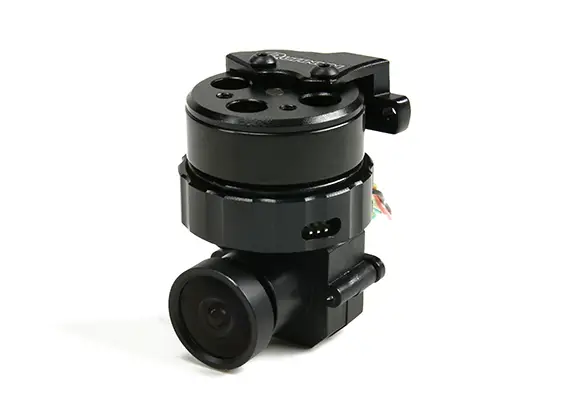
They are also cheaper than 2-axis and 3-axis gimbals as they have less parts. This is the main benefit of a single axis gimbal, they’re cheap and still get the job done.
2-axis drone gimbal
Drones will often use 2-axis gimbals as they can handle both tilt and roll which provides stable, high-quality footage.
2-axis gimbals balance movements in two directions, both tilt and roll (more on this below) and are of better quality than single axis gimbals.
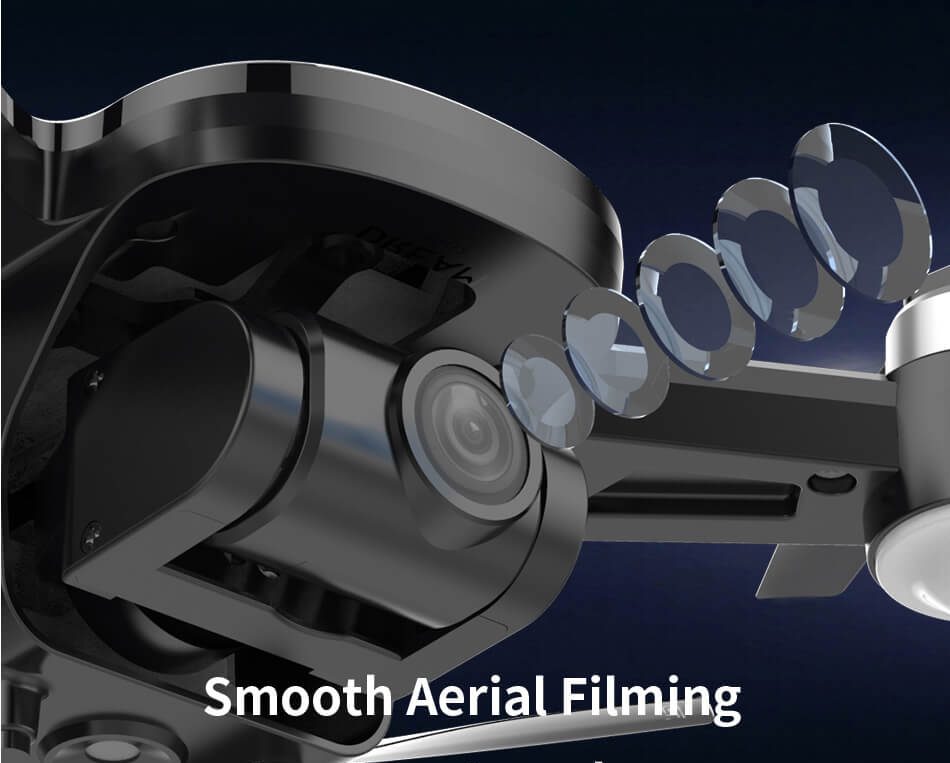
These are generally a little larger than single axis gimbals and cost a little more as they have one extra brushless motor.
The disadvantage with 2-axis gimbals is their lack of compensation in the yaw (pan) axis which can be noticeable in video footage. This creates what is called jittery horizontal or jello movement.
3-axis drone gimbal
When purchasing a drone that is on the expensive side, you’ll most likely find that it uses a 3-axis gimbal in order to provide the smoothest footage.
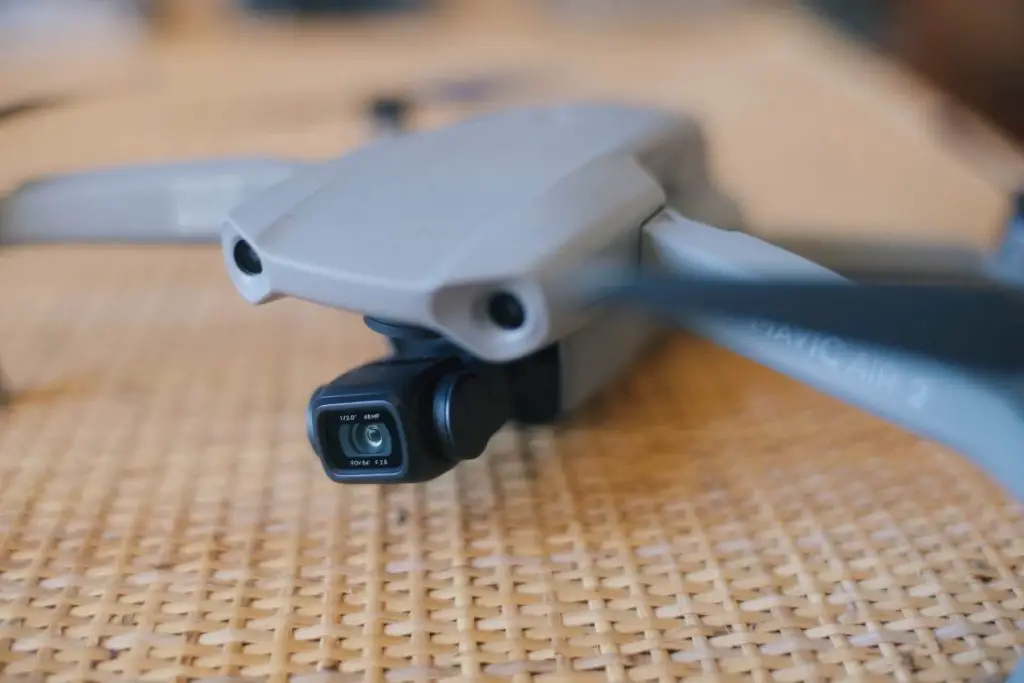
This will depend on the type of drone you buy. For example, if a drone is built to be long endurance (long flight times), then it may have a 2-axis gimbal as they are lighter and have less motors which results in less battery consumption.
3-axis gimbals balance tilt, pan and roll (we’re about to explain this don’t worry). This covers all possible angles which ensures you are getting incredibly smooth footage.
These gimbals however are the heaviest. They have 3 brushless motors that all consume battery power which reduces flight times of any drone.
They are also larger than the two gimbals above which can pose problems depending on the size of the drone that the gimbal is mounted to as they need to be well balanced on the drone in order for it to fly properly.
You’ll also be spending significantly more money with these gimbals as they are generally quite expensive.
How Does A Drone Gimbal Work?
Drone gimbals can stabilize your video in three different axes. These are the pitch, yaw, and roll axes (tilt, pan, and roll)
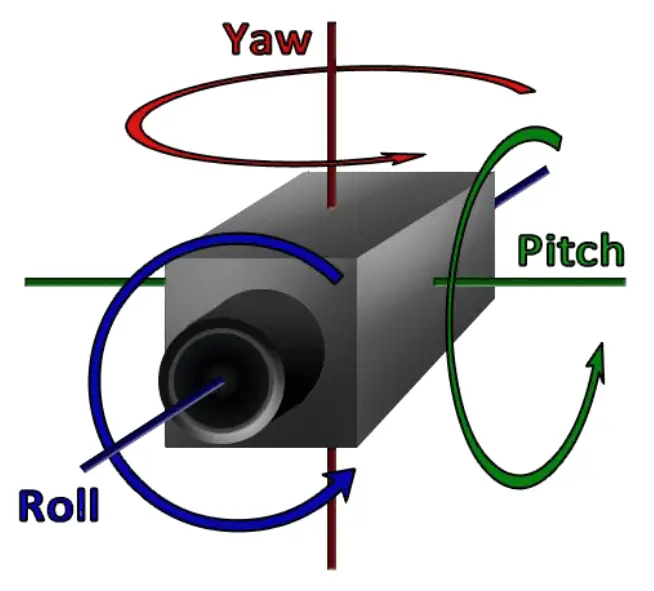
The yaw (pan) motion is a side to side movement of the camera (left to right). This is generally a 360 degree movement.
The pitch (tilt) motion is an up and down motion of the camera.
The roll motion rotates the camera to the left or right.
To recap on the above information, single axis gimbals only balance the tilt, 2-axis gimbals balance both the tilt and roll, and 3-axis gimbals balance the tilt, pan and roll.
Parts of a drone gimbal
Here are a few of the parts found in a gimbal. These parts all work in tandem to provide incredible drone footage without the need for human intervention.
Drone gimbal brushless motors
Most components that make up a drone gimbal (including the motors) are designed for a specific camera and sensor. This custom fit can be both beneficial and can pose problems.
This can be beneficial as this will mean that if you use the gimbal that was made for the specific camera and sensors, that will ensure you’ll obtain perfect footage as the gimbal was fine-tuned to the camera’s weight in order achieve the perfect balance.
A drone with an off balance camera or gimbal could damage a drone as it will need to compensate with more power on one propeller to keep it balanced. This will wear down that propeller a lot quicker and that includes the motor and rotor.
The fine tuning requirements can also pose problems as it will mean that it will be harder to find a gimbal to fit your specific camera and even your drone. You’ll need to find one that can fit without a problem.
Brushless motors usually have four or more magnets mounted around the perimeter of the rotor in a pattern that resembles a cross.
This leads to very efficient power consumption as the rotor has the magnets which reduce the power required to operate.
Drone gimbal camera and sensor
One of the most important parts of a gimbal is of course, the camera. The gimbal should have the appropriate screws, cables and mounts that can fit the camera to the gimbal and to the control unit (more on this below).
Damping anti-vibration absorber
Damping anti-vibration absorbers are essential to any gimbal. They are responsible for reducing or damping medium to high vibration frequencies that come from the drone and travel to the camera while allowing low frequency board movements to take place.
This is a part that is very important and cannot be overlooked. The dampers are placed between the gimbal and the drone. These dampers can be made from carbon fiber with anti-vibration plates that have 4 rubber balls that were made for the gimbal if done professionally.
Drone gimbal control unit (GCU)
The gimbal control unit (GCU) is a small computer that gets data from the gyroscope and uses that data to make the gimbal motors move together to point the camera in a certain direction.
This module communicates with the flight control system in order to aid in controlling the gimbal while sending video information to the video downlink for video transmission.
Drone gimbal inertial measurement unit (IMU)
Almost all drone gimbals have an inertial measurement unit (IMU) built-in. This part makes use of algorithms programmed to make it effortless for the drone’s operator as they create nearly complete stabilisation.
This component is built-in and therefore will not require any added wiring.
The IMU can measure the force, angular rate and even the magnetic field surrounding an object by making use of accelerometers and gyroscopes. This data can enable a computer to track a drone’s position.
However, the IMU can be misaligned. If it’s misaligned, the camera should be fixed to record the horizon with a straight line. If it’s not a straight line, then you can have horizon tilt problems which can be fixed by calibrating the drone gimbal and IMU. In addition there are several other ways to fix this issue.
What Is The Difference Between A Gimbal And A Steadicam?
It’s important to note that gimbals and Steadicam’s are both stabilisers that have the same function. However, they work in different ways to achieve the same goal.
Steadicam’s have been used for many years in the filmmaking industry. They are very cool devices that are attached via a vest to professionally trained operators. There are springs in the system and the operator also participates actively in the stabilisation of the image by moving smoothly to catch the shot. With a gimbal, a lot of the work the Steadicam operator performs is instead done by a specialised computer with IMU and motors programmed to perform the stabilisation.
Here is a video going through the differences between the two, including their advantages and disadvantages.
How To Choose The Right Gimbal For Your Drone
If you’re trying to choose the right gimbal for your drone, we’ve got you covered!
Take note that drones that are more on the expensive side tend to come with high-quality cameras and gimbals included. More often then not, this camera and gimbal has been specifically built for the drone model.
You’ll see this with industry leaders such as DJI or Parrot who have their own line of drones and gimbals that were custom made for each model in order to maximise the quality of footage.
If you plan on buying a gimbal to attach to your drone and camera yourself, you’ll need to do some research to make sure the gimbal is compatible for your specific drone and camera.
Factors you should keep in mind when choosing a gimbal
Here are a few important factors you should take into account before choosing just any old gimbal for your drone. This may save you the hassle of buying a gimbal just to realise it doesn’t fit your drone or your camera!
Amount of axes
Remember the differences we talked about above? You’ll generally find that drones have either 2-axis or 3-axis gimbals. The major difference is that 3-axis gimbals provide smoother footage. 2-axis gimbals are generally lighter giving you longer flight times and they’re cheaper than 3-axis gimbals.
Camera support
Most gimbals are designed with specific cameras in mind. This means that if you don’t have that type of camera, it most likely won’t fit. You’ll need to do some research to find out if the gimbal you’re choosing to buy supports the camera you have.
Take note that some gimbals are built to be more universal (support multiple camera types), however, these gimbals are not considered to be as good as ones that we’re custom made for specific cameras.
Pre-calibration
Some gimbals may come calibrated for you, and some may not. If you’re just a beginner, this can be a tedious process. If you’re buying a gimbal made for a specific drone, then you’re probably going to recieve a pre-calibrated gimbal.
Gimbal weight
The weight of the gimbal is extremely important. This is what’s could severely reduce your flight time if you’re not careful.
Make sure you don’t buy a gimbal that’s too heavy for your drone, no matter the amount of axes. Try and find one that has a good balance between weight and features so that you can get the best of both worlds.
If you want the absolute best footage possible and decide to buy a heavy 3-axis gimbal, just remember that you could potentially be cutting your flight time into two.
Gimbal payload
The payload of the gimbal can also be important. This will only be a problem if you decide to use a large camera with your gimbal.
With a drone, you’ll most likely be trying to keep it as small as possible. This could still be quite an important factor to look out for.
Additional features
Additional features such as remote control integration with your gimbal can allow you to control your gimbal remotely straight from your drone controller. This can be an incredible feature to have.
However, this will most likely only be found when you purchase a drone that has a built-in gimbal from manufactories such as DJI.
You can also look for a gimbal that has an easy to release system for your camera if you plan on taking it on and off often.
How Much Does A Drone Gimbal Cost?
Drone gimbals range in price depending on the quality of the gimbal and the person who’s selling it. If you decide to buy one from industry leaders such as DJI, then you may find them to be quite expensive.
However, you can be confident that they will be of good quality.
Drone gimbals cost around $100 or cheaper for a gimbal that is not great quality whereas a gimbal of better quality that can support more camera models can be priced from $400 or more.
It’s important to note that large companies such as DJI or Yuneec will more often than not sell gimbals that have cameras included. Be ready to pay a lot more if you plan on buying a gimbal with camera. These tend to cost $1,000 and up if they’re good quality.
A drone gimbal that has more axes is going to cost more as well.
An example of a drone gimbal with a camera included is the Yuneec E30Z for H520 which will set you back around $4,347 USD.
An example of a drone gimbal without a camera would be the DJI X-Port which will set you back $390
Why are gimbals so expensive?
They’re very expensive as they are still a fairly new technology. They are very useful to have and they get the job done.
This sort of technology was not always as cheap as it is now and was mainly bought and used by professional filmmakers.
Gimbals require little training as they are almost entirely automatic. All that you need to do is provide the device with power and it will do the rest of the work for you.
It has also evolved a good amount to be sold on the market for everyone. Steadicam’s used to be the only viable option for capturing professional grade stable footage.
With the creation of gimbals, this has now become technology for everyone who has disposable income.
Where To Find A Drone Gimbal
Here are a few websites that sell gimbals:
- Amazon.com: You can’t go wrong with Amazon. You should know by now that you’ll be able to find nearly anything you could possibly want on Amazon, including drone gimbals.
- ReadymadeRC.com: This website has many products for U.S. and Canadian customers
- Helipal.com: This drone website is a great option for customers based outside of the U.S.
Gimbal VS No Gimbal
Here is a short video demonstrating the differences in quality when a drone has and doesn’t have a gimbal equipped:
Conclusion
Gimbals are a new technology that is continuing to evolve at a very rapid pace. Drones have greatly benefited from the implementation of gimbals and have taken aerial photography to an entire new level.
We have no doubt that it will continue to evolve and demand for drone gimbals will continue to rise as time goes on.
If you’re still trying to decide whether to get a drone with a gimbal, or add a gimbal to your drone, then we would like to part with you by saying that you should definitely invest in one if you plan on using your drone for photography and you have some additional disposable income.
We hope you enjoyed this post and learned something new!
